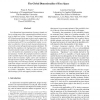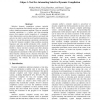8620 search results - page 1610 / 1724 » Modeling the Human in Human Factors |
SIGGRAPH
2010
ACM
14 years 2 months ago
2010
ACM
This paper introduces an approach to control of physics-based characters based on high-level features of movement, such as centerof-mass, angular momentum, and end-effectors. Obje...
FGR
2000
IEEE
14 years 2 months ago
2000
IEEE
Low-dimensional representations of sensory signals are key to solving many of the computational problems encountered in high-level vision. Principal Component Analysis (PCA) has b...
ICRA
2000
IEEE
14 years 2 months ago
2000
IEEE
We describe a new theoretical framework for robot-aided training of arm movements. This framework is based on recent studies of motor adaptation in human subjects and on general c...
MICRO
2000
IEEE
14 years 2 months ago
2000
IEEE
Selective dynamic compilation systems, typically driven by annotations that identify run-time constants, can achieve significant program speedups. However, manually inserting ann...
VISUALIZATION
2000
IEEE
14 years 2 months ago
2000
IEEE
Throughout the design cycle, visualization, whether a sketch scribbled on the back of a spare piece of paper or a fully detailed drawing, has been the mainstay of design: we need ...


